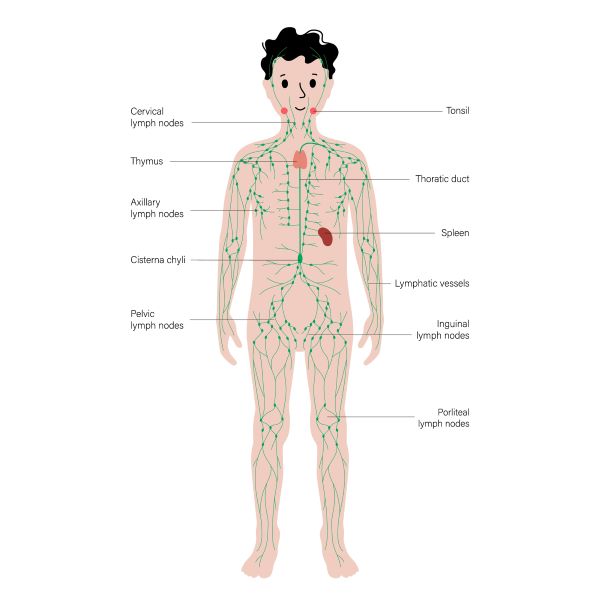What is the Lymphatic System?

The Lymphatic system is an organ system that works within the immune system to protect the body from infections. It is comprised of lymphatic vessels, lymph nodes, lymphoid/lymphatic organs, and lymphoid tissues that work together to transport lymph throughout the body. Lymph, a clear fluid made of white blood cells, aids in fighting diseases. Lymphatic vessels carry lymph fluid to lymph nodes where it is then filtered before being carried back into the bloodstream. Lymph nodes are small glands (located in the neck, under the arms, elbows, chest, abdomen, and groin) containing lymphocytes that attack and break down bacteria and viruses found in the lymph fluid.
How do Lymphatic Malformations Develop?
When lymphatic vessels don’t properly form in utero it creates blockages that prevent proper drainage of lymph fluid. The pooling lymph fluid makes the vessels swell causing the spongy cluster of cysts that appear as masses. These lymphatic malformations may also grow due to bleeding from small veins contained within the malformed vessels.
Types of Lymphatic Malformations
There are 3 types of lymphatic malformations: microcystic, macrocystic, and a combination of both. Lymphatic malformations can mainly be differentiated by size.
- Microcystic lymphatic malformations develop as several small, raised blister-like sacs on the skin and are, called lymphatic blebs. The sacs can appear clear with lymph fluid or darker if blood is present. These smaller, spongy-like cysts generally grow slowly or in proportion with the child.
- Macrocystic lymphatic malformations have large cysts (more than 2 cm in diameter) filled with lymph and/or blood. They appear as soft masses under the skin and can have a blueish tint from blood. Macrocystic malformations are commonly found in the neck; however, they can be found near the armpits, groin, chest wall, or hip region. Also referred to as lymphangiomas.
Most lymphatic malformations have a mix of both microcystic and macrocystic.
What Causes Lymphatic Malformations?
Lymphatic malformations form early on in pregnancy. There is no known cause for lymphatic malformations. It is thought to happen randomly, at no fault to the mother. Some severe lymphatic malformations have genetic mutations identified, but are thought to be random and not inherited. LM is more common in children with:
- Down Syndrome
- Turner syndrome
- Noonan syndrome
- An overgrowth syndrome
Symptoms of Lymphatic Malformations
Symptoms of lymphatic malformations can vary based on the size and location of the mass. Most malformations grow as the patient does. Despite the size, LM can cause impairment of nearby organs or structures as the growing mass can place pressure on surrounding body parts. Babies can have more than 1 lymphatic malformation that affects multiple areas. General symptoms can include:
- Pain and swelling of the area
- Infection
- Overgrowth in area
- Vesicles (look like tiny blisters) over the malformation
- Bleeding into the malformation (bruise appearance)
- Inflammation (cellulitis)
As lymphatic malformations can occur anywhere on the body, symptoms specific to the affected area include:
Tongue, mouth, windpipe malformations
-
-
- Trouble with speaking
- Difficulty breathing & swallowing
- Feeding problems
Eye socket malformations
-
-
- Double vision (diplopia)
- Bulging of the eye (proptosis)
Chest malformations
-
-
- Wheezing
- Chest pain/pressure
- Trouble breathing
- Narrowing of airways
Gastrointestinal tract malformations
-
-
- Rectum bleeding
- Constipation
- Bladder obstruction
- Infections
Genitourinary malformations (kidney and bladder)
-
-
- Blood in urine
- Pain when urinating
- Bone malformations
- Bone overgrowth
- Bone loss
- Fracture
Diagnosis of Lymphatic Malformations
Lymphatic malformations typically form between the 9th and 16th weeks of pregnancy and can often be diagnosed in utero with a prenatal
ultrasound scan. Cases not found in utero can be diagnosed after the baby is born. Most malformations are diagnosed by the age of two, if missed during pregnancy. These diagnostic tests include:
 The Lymphatic system is an organ system that works within the immune system to protect the body from infections. It is comprised of lymphatic vessels, lymph nodes, lymphoid/lymphatic organs, and lymphoid tissues that work together to transport lymph throughout the body. Lymph, a clear fluid made of white blood cells, aids in fighting diseases. Lymphatic vessels carry lymph fluid to lymph nodes where it is then filtered before being carried back into the bloodstream. Lymph nodes are small glands (located in the neck, under the arms, elbows, chest, abdomen, and groin) containing lymphocytes that attack and break down bacteria and viruses found in the lymph fluid.
The Lymphatic system is an organ system that works within the immune system to protect the body from infections. It is comprised of lymphatic vessels, lymph nodes, lymphoid/lymphatic organs, and lymphoid tissues that work together to transport lymph throughout the body. Lymph, a clear fluid made of white blood cells, aids in fighting diseases. Lymphatic vessels carry lymph fluid to lymph nodes where it is then filtered before being carried back into the bloodstream. Lymph nodes are small glands (located in the neck, under the arms, elbows, chest, abdomen, and groin) containing lymphocytes that attack and break down bacteria and viruses found in the lymph fluid.















